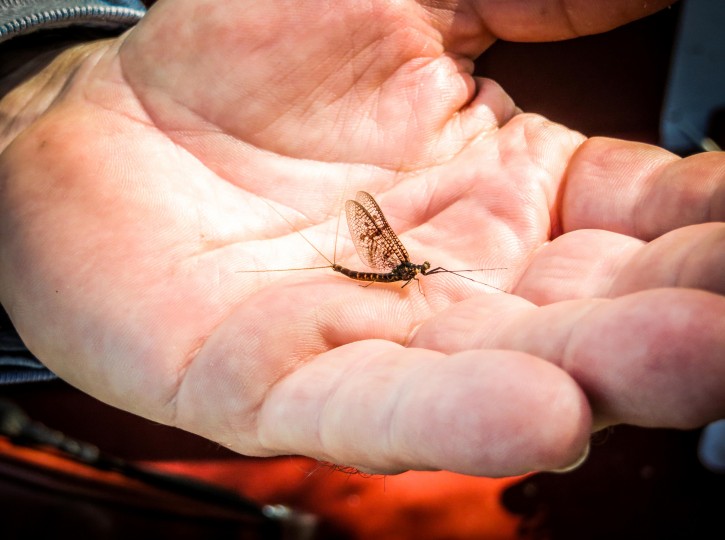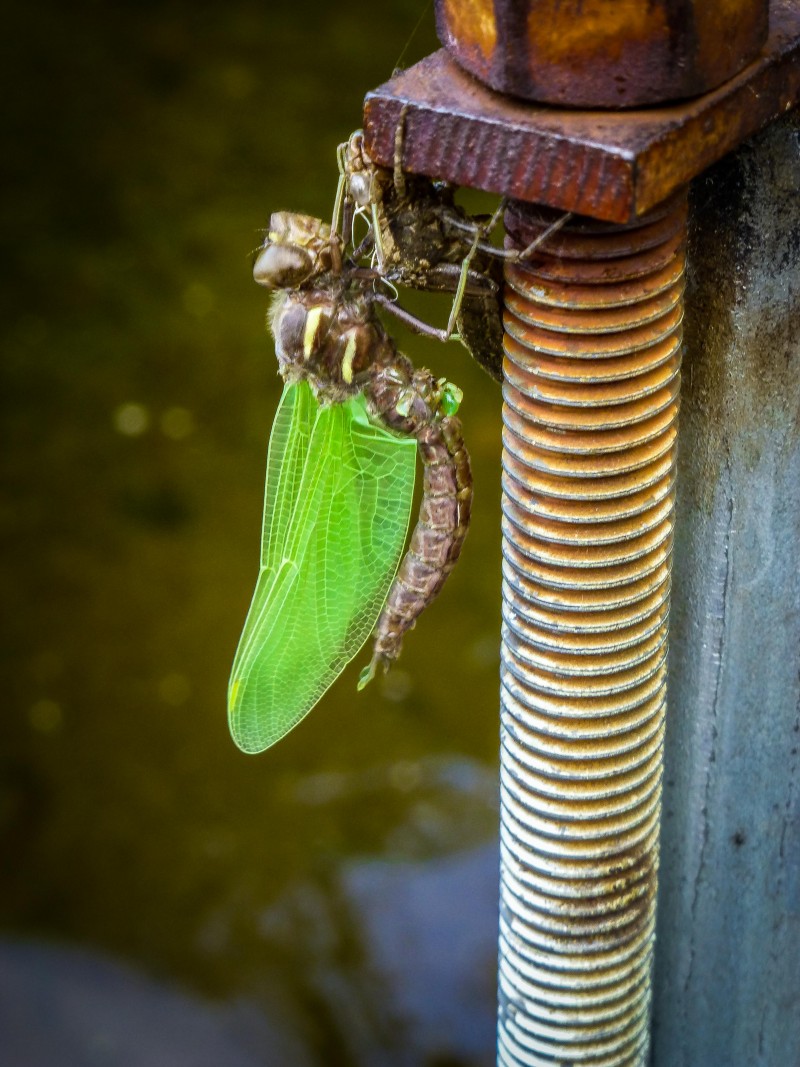By: Steve Root aka “Rootski”
So you’ve become interested in Fly Fishing. Great! Maybe you saw somebody out on your favorite lake and it looked like he was having fun. Or maybe you’ve always had an interest but never really got serious about it until now. When you start taking a closer look it becomes obvious that there is a lot to learn. Fly fishing has its own technical sounding jargon, gadgets and gizmos, not to mention hundreds of different fly rods and fly lines. It can be overwhelming!
Fortunately we’re living in a time when information is readily available. Thirty years ago it was hard to get solid input on how to cast, which rod or line to use, or what flies you might need. It took years of trial-and-error to get a handle on it. Now of course there are dozens of good books, magazine, and videos out there. And the Internet! Several of the major manufacturers like Orvis, Scientific Anglers, or Rio have a ton of information on their websites.
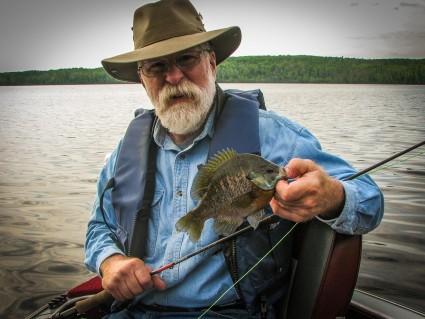 But there are some pitfalls. A lot of the information is being written by people who don’t remember when they didn’t know anything. You feel like you just walked in half way through the movie. It’s familiar, but you really aren’t sure what’s going on. The other thing that happens is the inevitable picture of a guy in $500 waders holding a 30 inch long Rainbow trout he caught with his $800 fly rod in Alaska or Chile. OK, maybe that’s not fair. He might be holding a Bonefish he caught in the Bahamas or on Christmas Island out in the distant Pacific. I don’t know about you, but that lifestyle is above my pay grade. It can get discouraging. I’m here to tell you there’s a lot more to fly fishing than that. Don’t give up yet!
But there are some pitfalls. A lot of the information is being written by people who don’t remember when they didn’t know anything. You feel like you just walked in half way through the movie. It’s familiar, but you really aren’t sure what’s going on. The other thing that happens is the inevitable picture of a guy in $500 waders holding a 30 inch long Rainbow trout he caught with his $800 fly rod in Alaska or Chile. OK, maybe that’s not fair. He might be holding a Bonefish he caught in the Bahamas or on Christmas Island out in the distant Pacific. I don’t know about you, but that lifestyle is above my pay grade. It can get discouraging. I’m here to tell you there’s a lot more to fly fishing than that. Don’t give up yet!
I’d like to describe an alternative way to approach this that is affordable and a lot of fun. First, let’s think back to the days when we first started fishing. I’m thinking about that cheap rod and closed face reel outfit, the one with the mono that was permanently twisted into a spiral. Round, red and white plastic bobbers, big split shot, gold Aberdeen hooks. An old metal tackle box full of stuff Grandpa gave you that he never, ever actually caught a fish on. Crappie minnows, chunks of night crawlers, wax worms. Remember? You caught dozens and dozens of fish and you caught everything in the lake: Bass, Sunfish, Crappies, Pike, Carp, Bullheads, Rock Bass, Perch, maybe even a Walleye or two. It was a hoot! It actually worked well, because you were using bait that closely resembled the majority of the food in a lake.
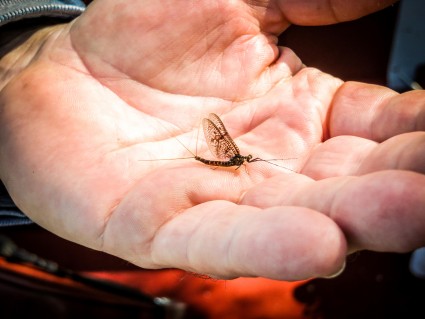 Your average lake is full of bugs like Mayfly nymphs, Dragonfly and Damselfly nymphs, Bloodworms, Caddis Fly larvae, and Scuds. Then add in the recently hatched fry along with most species of minnows and what you can conclude is that your lake has a lot of edible little morsels that happen to be about the size of a Crappie minnow, a chunk of night crawler, or a 1/6th ounce Beetle Spin. No wonder you were catching everything in sight. Now what does this have to do with fly fishing?
Your average lake is full of bugs like Mayfly nymphs, Dragonfly and Damselfly nymphs, Bloodworms, Caddis Fly larvae, and Scuds. Then add in the recently hatched fry along with most species of minnows and what you can conclude is that your lake has a lot of edible little morsels that happen to be about the size of a Crappie minnow, a chunk of night crawler, or a 1/6th ounce Beetle Spin. No wonder you were catching everything in sight. Now what does this have to do with fly fishing?
Over the years fly tiers have come up with patterns that do an excellent job of duplicating all those critters mentioned above. And I’m not talking about complicated flies that use exotic feathers and fur either. There are simple flies that do a dandy job of imitating minnows and insects.
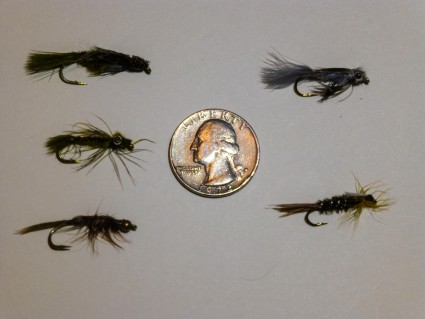 Let’s put two and two together. Imagine you’re out on the water on a beautiful warm early summer day with a fly rod and a fly that looks like a bug or a minnow. You can catch every species of fish in that lake. You might spend a morning on the water and catch 50 or 75 fish! They’re not all going to be monsters but if you’re looking for action and fun, this is hard to beat. And if you decide you really want to get into this Fly Fishing stuff “seriously”, there’s no better way to practice all the skills you will need than spending time on the water having fun. If you decide to pursue Bass or Trout or some other type of fish you will be using a lot of the same skills and lessons learned while you were out “messing around”.
Let’s put two and two together. Imagine you’re out on the water on a beautiful warm early summer day with a fly rod and a fly that looks like a bug or a minnow. You can catch every species of fish in that lake. You might spend a morning on the water and catch 50 or 75 fish! They’re not all going to be monsters but if you’re looking for action and fun, this is hard to beat. And if you decide you really want to get into this Fly Fishing stuff “seriously”, there’s no better way to practice all the skills you will need than spending time on the water having fun. If you decide to pursue Bass or Trout or some other type of fish you will be using a lot of the same skills and lessons learned while you were out “messing around”.
Let’s talk about gear. This doesn’t have to be expensive, and frankly if you’re not sure you really want to get into this in a big way you shouldn’t spend a lot of money on a rod that just ends up sitting in the corner. There isn’t anything specific that you absolutely need for this kind of fishing, rather there’s a range of gear that is suitable and practical. Think about the spinning rod you might use. Anything from a four foot long ultra-light to a seven foot medium action rod would do the job and be fun to use. Fly rods are rated by line size, from very light (2 or 3 weight) all the way up to telephone poles (14-16 weights). There are tradeoffs on either end. The lighter weights are fun but you’ll struggle if there’s any wind or if you hook a big fish. The heavier weights make it hard to be delicate, for example dropping a fly in shallow water without spooking the fish. If you already have a rod, anything up to a 6 or 7 weight will work just fine. If you’re going to buy something, consider getting a 6 weight. A decent 6 weight rod is the fly fishing equivalent of that medium action spinning rod and can be used for anything from Trout to Bass. It doesn’t have to be the latest and greatest fast action graphite either. The slower action a fly rods has, the easier it is to cast. IM6 graphite rods are just fine and won’t break the bank.
You won’t need much of a reel either. Ninety-nine percent of the time the reel is just storing line. You won’t be fighting fish off the reel (you just “hand line” them) and a Bluegill isn’t going to make a 100 yard run into your backing so the drag isn’t important either. A simple click drag single action reel fills the bill and is inexpensive too.
You can do most of your fishing with one Fly line. A weight forward floating line (WF6F, for example) will do a great job of this. If you need to get deeper you can use weighted flies or even add a couple of small split shot to the line. A good line is a pleasure to use and is worth the investment.
There are several manufacturers who sell pre-rigged packed outfits. 3M/Scientific Anglers, Cabela’s, and Redington all sell these kits. They offer a rod, reel, and a fly line in one box. It’s not a bad way to go. The rods are pretty good, the reels do everything you need them to do, and the lines are adequate. The first thing you might replace is the line, but it is fishable right out of the box.
One of the nice things about this is the fact that you don’t need a fancy leader, a super long leader, or a heavy duty leader. You could use six feet of six or eight pound test monofilament and catch a lot of fish. Or for a few dollars you could buy a tapered leader and add a tippet to it, allowing you to make a nicer presentation. A tapered leader is just what it sounds like. The end that connects to your fly line is thick and gently tapers down to a small tip. You can buy these leaders in different lengths and tip sizes. Typically they are either nine or 12 feet long and anywhere from 10 pound test on down. I’d recommend a nine footer that tapers down to six or eight pound test, and then use a blood knot to tie on a couple of feet of six pound monofilament (the “tippet”). The idea here is that every time you tie on a fly, you use up a little bit of leader. If you tie on a section of tippet, you use that up and when it gets short you replace it with another longer piece of tippet.
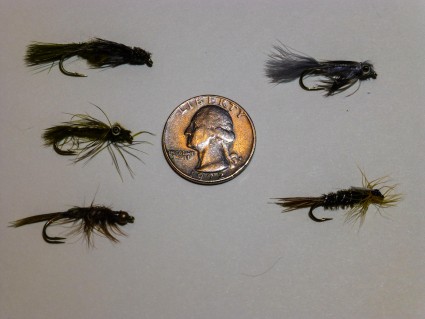 There are some standard fly patterns out there that work really well. Remembering the size bait we’re trying imitate, this is going to be a fly tied on a #10 or #8 hook. On some occasions a #6 might be warranted or on the other extreme as small as a #14, but again we’re talking about morsels of food that are up to an inch long or so. Wooly Buggers come in all shapes and sizes. Black, brown, and Olive colored Buggers will represent a lot of things like nymphs and leeches. In lighter colors they can suggest a minnow. A #6 yellow cone head Wooly Bugger is usually the very first fly I pull out of the box! Smaller nymphs can be important in the spring when the water is first warming up. Pheasant tail nymphs do a great job of imitating these smaller Mayfly nymphs. The early bugs are really small, like a #10 or #12 fly. Even though these flies look tiny, they represent a lot of the available food in the spring and it’s surprising what they will eat. I’ve caught plenty of big Bass on tiny little nymphs in the early spring. Think about the Bass that get caught by ice fisherman on tiny little jigs. Bigger flies will work but not as well.
There are some standard fly patterns out there that work really well. Remembering the size bait we’re trying imitate, this is going to be a fly tied on a #10 or #8 hook. On some occasions a #6 might be warranted or on the other extreme as small as a #14, but again we’re talking about morsels of food that are up to an inch long or so. Wooly Buggers come in all shapes and sizes. Black, brown, and Olive colored Buggers will represent a lot of things like nymphs and leeches. In lighter colors they can suggest a minnow. A #6 yellow cone head Wooly Bugger is usually the very first fly I pull out of the box! Smaller nymphs can be important in the spring when the water is first warming up. Pheasant tail nymphs do a great job of imitating these smaller Mayfly nymphs. The early bugs are really small, like a #10 or #12 fly. Even though these flies look tiny, they represent a lot of the available food in the spring and it’s surprising what they will eat. I’ve caught plenty of big Bass on tiny little nymphs in the early spring. Think about the Bass that get caught by ice fisherman on tiny little jigs. Bigger flies will work but not as well.
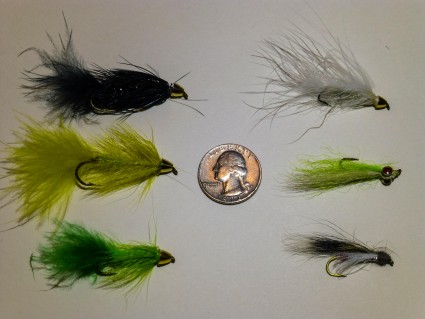 Later on, different bugs start moving and hatching and you might find different flies work better. For example, when you start seeing Dragonfly nymphs crawling up onto the docks and hatching it’s time to try a bigger fly. These are pretty good sized bugs and there are millions of them so the fish will focus on them. I’ve seen Bluegills ignore small brown nymphs and climb all over bigger grey ones at this time. Most any small streamer can imitate a minnow. Clouser minnows or Deceivers in the right sizes catch a lot of fish. And depending on water clarity, it might be a good idea to have some flies with fluorescent colors or tinsels tied into them. This is a lot like picking out jigs for springtime Crappie fishing. Sometimes the color doesn’t matter, and sometimes it does. If you have to experiment it’s nice to have several options.
Later on, different bugs start moving and hatching and you might find different flies work better. For example, when you start seeing Dragonfly nymphs crawling up onto the docks and hatching it’s time to try a bigger fly. These are pretty good sized bugs and there are millions of them so the fish will focus on them. I’ve seen Bluegills ignore small brown nymphs and climb all over bigger grey ones at this time. Most any small streamer can imitate a minnow. Clouser minnows or Deceivers in the right sizes catch a lot of fish. And depending on water clarity, it might be a good idea to have some flies with fluorescent colors or tinsels tied into them. This is a lot like picking out jigs for springtime Crappie fishing. Sometimes the color doesn’t matter, and sometimes it does. If you have to experiment it’s nice to have several options.
And finally there is one of the all-time most entertaining ways to fish that I can think of, throwing top water flies. A Medium sized popper will attract a lot of attention from quite a few different species of fish and under the right circumstances can lead to an exciting day on the water. It helps to have calm conditions, some shallow cover like weeds or wood, and water temps at least 55 degrees. You never quite know what will hit next but you will have plenty of action. I should mention that some of the very biggest Crappies I’ve ever caught came on Poppers. White, Yellow, and Black are all good color schemes for Poppers.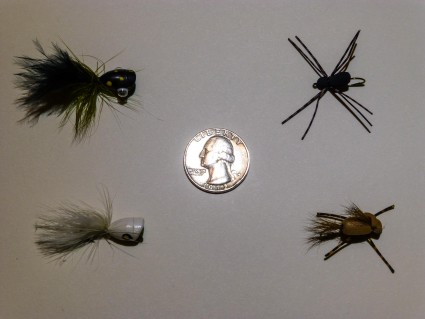
Let’s go on a typical morning’s adventure and talk about some situations and strategies. It’s June and the water has been getting warmer for the last few weeks. There are the beginnings of some solid weed beds, and most of the fish are either spawning (like pan fish) or they’re done and back feeding again. We’re using a 5 weight fly rod with a weight forward line, a nine foot leader, and to start with a small olive cone head Wooly Bugger in size 8. This fly is slightly weighted not unlike a very small jig.
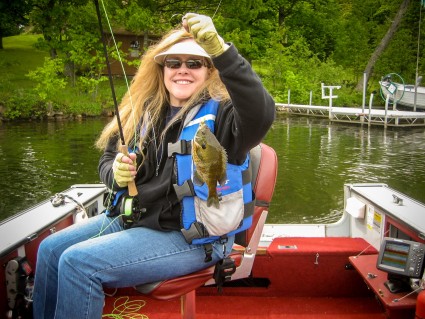 It will sink slowly, perfect for fishing shallow water. I’m looking for targets. Shady spots under trees or docks, reed beds, the edges of newly emergent weed beds, or downed trees. Using an electric trolling motor, a convenient breeze, or even oars, I’ll move slowly along trying to drop a fly into a likely looking spot. Make your cast, keep the rod pointed at the fly and the rod tip down near the surface. Gently pull out the slack and let the fly sink. Then give it a couple of twitches and let it sink again. You either feel a “thunk” come up the line or you’ll see the hit. Watch the end of your fly line. If it twitches or moves at all, set the hook! It always pays to experiment with different retrieves. Some bugs, like the Dragonfly and Damselfly nymphs, are surprisingly good swimmers. A faster steady retrieve must be just the ticket. If there are small minnows along the bank, a quick jerky retrieve can work very well.
It will sink slowly, perfect for fishing shallow water. I’m looking for targets. Shady spots under trees or docks, reed beds, the edges of newly emergent weed beds, or downed trees. Using an electric trolling motor, a convenient breeze, or even oars, I’ll move slowly along trying to drop a fly into a likely looking spot. Make your cast, keep the rod pointed at the fly and the rod tip down near the surface. Gently pull out the slack and let the fly sink. Then give it a couple of twitches and let it sink again. You either feel a “thunk” come up the line or you’ll see the hit. Watch the end of your fly line. If it twitches or moves at all, set the hook! It always pays to experiment with different retrieves. Some bugs, like the Dragonfly and Damselfly nymphs, are surprisingly good swimmers. A faster steady retrieve must be just the ticket. If there are small minnows along the bank, a quick jerky retrieve can work very well.
There are a few things you can do with a fly rod that you really can’t do any other way. Obviously you can pitch a small lure into shallow water with less commotion than you ever could with a spinning rod. And there are other tricks you can pull out of your sleeve as well. In Minnesota it is legal to use up to three flies on the same leader. It can be very effective, especially in dirty or stained water, to use a Popper and a nymph on the same leader. Tie the nymph off the hook eye of the Popper so it runs a foot or two behind. The Popper makes a lot of noise and attracts attention. Even if the fish decides it isn’t going to eat that top water fly, it might find that fat juicy looking bug right behind too good to pass up. The Popper-Dropper rig can be deadly. Alternatively you could run two different nymphs or streamers at the same time to see if there is any preference.
Cold water usually means small flies and slow retrieves. Last May we found some tough conditions where we were on a lake a week after ice-out. The fish were there to be caught but it took some adjusting.
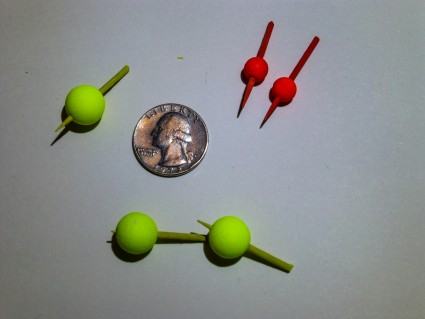 Everything we caught (Bass, Bluegills, Crappies, Perch) all wanted the fly to be barely moving. To do this, I used what is called a “strike indicator”. That’s fly-fishing lingo for “bobber”. These things come in a variety of sizes and shapes. I use the small round foam ones that look like old-fashioned ice fishing bobbers. With this “strike indicator” up the leader, I could present my little black fly right in their faces without moving it very fast. Then all I had to do was watch the indicator for signs of a strike and I was in business. This isn’t anything exotic; it’s the good old “jig and a bobber” that people have been using for years.
Everything we caught (Bass, Bluegills, Crappies, Perch) all wanted the fly to be barely moving. To do this, I used what is called a “strike indicator”. That’s fly-fishing lingo for “bobber”. These things come in a variety of sizes and shapes. I use the small round foam ones that look like old-fashioned ice fishing bobbers. With this “strike indicator” up the leader, I could present my little black fly right in their faces without moving it very fast. Then all I had to do was watch the indicator for signs of a strike and I was in business. This isn’t anything exotic; it’s the good old “jig and a bobber” that people have been using for years.
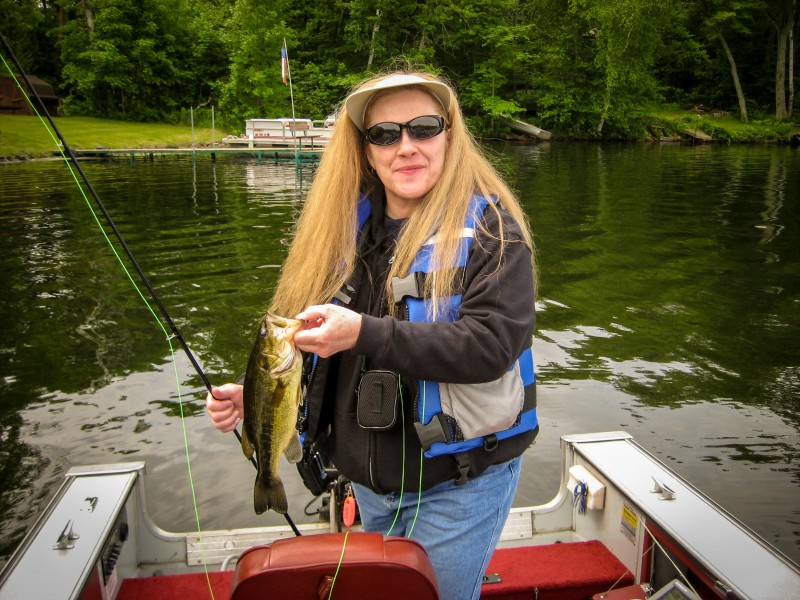 Later on in the summer, most fish start relating to deep weed edges. To get a fly in front of them might mean getting it 10 feet deep. There are a couple of ways to do this. You can add weight to the leader by using split shot. This works, but it’s tough to cast. The other thing to try is a section of sinking line. Several different companies now sell sections of “sink tip” that you can add with loop to loop connections between the fly line and a leader. In this case, your leader should be a short section of monofilament with no taper. A three or four foot leader is plenty long. Either way, the idea is to cast out parallel to the weed line and let it sink. This is where you apply the count-down method. When the fly line lands on the water you start counting. What you’re looking for is the magic amount of time that gets your fly down there but just above the weeds. A slow halting retrieve along the deep weed line can produce fish after fish, and you’re never quite sure what will hit next.
Later on in the summer, most fish start relating to deep weed edges. To get a fly in front of them might mean getting it 10 feet deep. There are a couple of ways to do this. You can add weight to the leader by using split shot. This works, but it’s tough to cast. The other thing to try is a section of sinking line. Several different companies now sell sections of “sink tip” that you can add with loop to loop connections between the fly line and a leader. In this case, your leader should be a short section of monofilament with no taper. A three or four foot leader is plenty long. Either way, the idea is to cast out parallel to the weed line and let it sink. This is where you apply the count-down method. When the fly line lands on the water you start counting. What you’re looking for is the magic amount of time that gets your fly down there but just above the weeds. A slow halting retrieve along the deep weed line can produce fish after fish, and you’re never quite sure what will hit next.
So that’s it. Keep it simple, use medium sized baits, and have fun!
